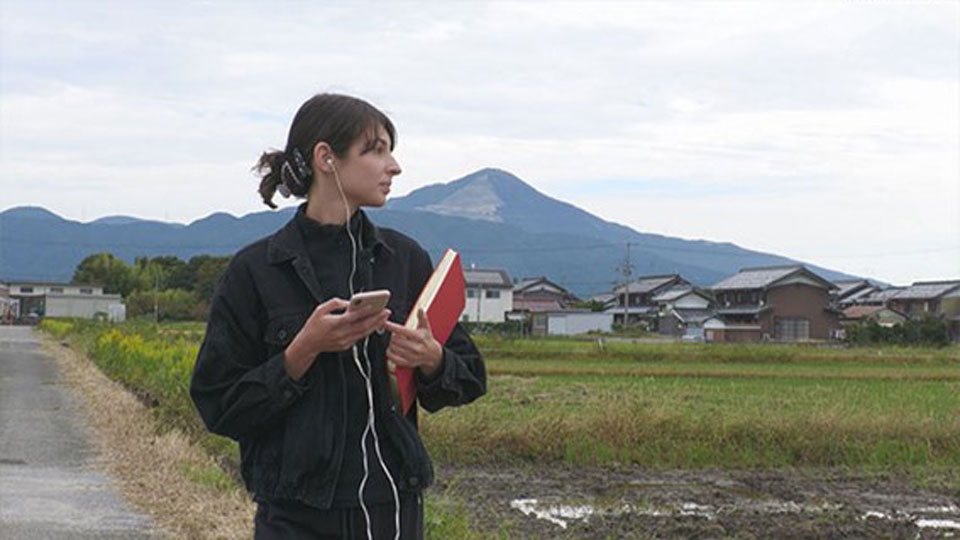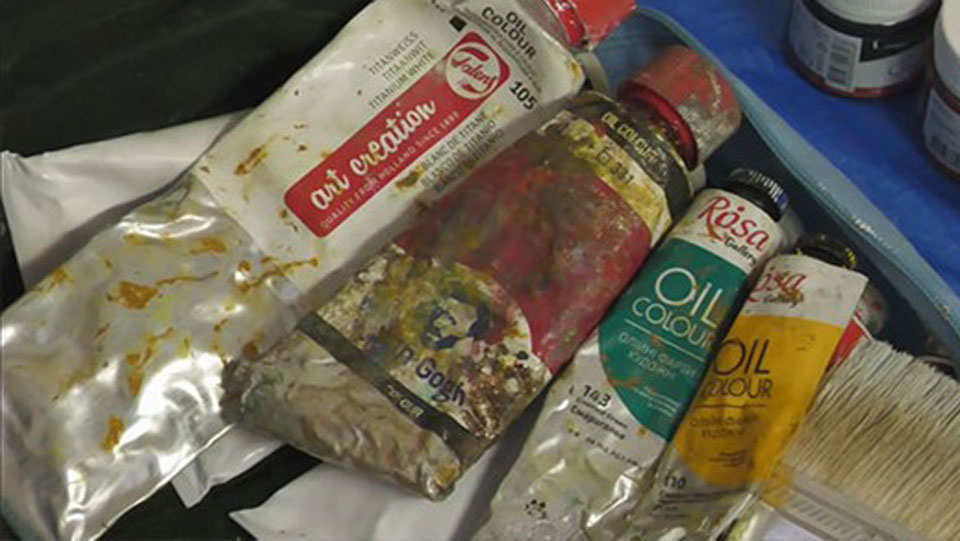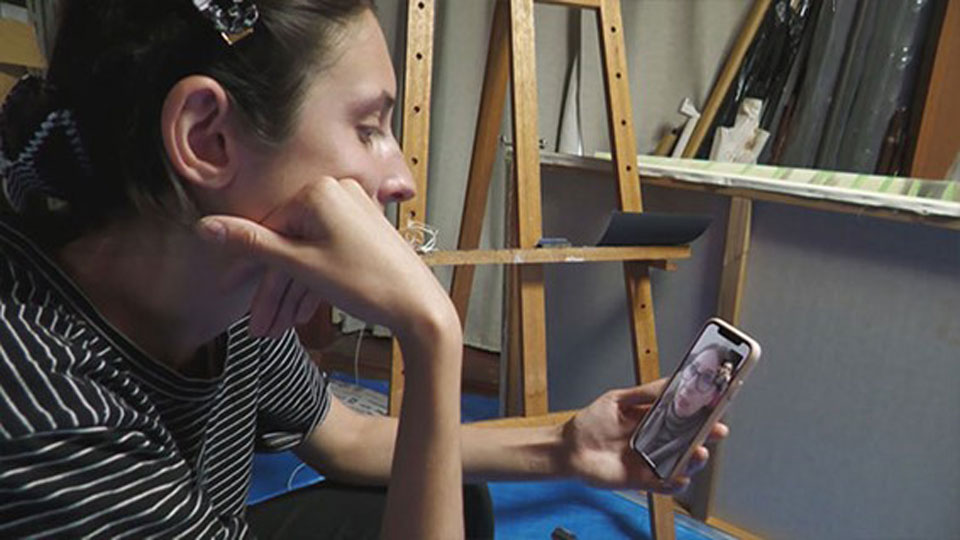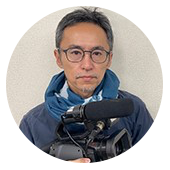
Twenty-three-year-old Filatova has seven paintings on show, along with works by Japanese artists, at an exhibition staged by the Jogon-in temple in Omihachiman city.
Filatova is from Zaporizhzhia, in southeastern Ukraine. As Russian attacks intensified in June, she fled to the Slovakia border. Her parents stayed behind, reluctant to abandon the family home. She landed in Japan at the end of August.

The program Filatova has joined is organized by Nishimura Nonki, a 65-year-old artist with a studio in Nagahama city, northern Shiga Prefecture.

Nishimura is welcoming overseas artists to Japan for the first time in three years, after suspending the program due to the coronavirus pandemic. He received many applications from Ukraine, but says Filatova's stood out.

"She wrote that she wanted to paint landscapes from before the war: scenery that remains in her heart, but has been damaged or lost in the fighting," he says.
"Her words seemed so full of hope for peace, I was sure they would appeal to anyone, so I wanted her to join us in Japan."
Sharing the residence program with Filatova are visiting artists from South Korea and Poland.
A landscape preserved in art
The first work Filatova produced in Japan is an oil painting.

"Sunset from my Window in Zaporizhzhia" depicts the view from the ninth-floor apartment where she lived with her parents.

Filatova brought her own paints, palette and brushes from Ukraine.
"It was in March, in spring," she says about the work. "No one knew what was going to happen next. I had been staying at home, gazing out the window, when I was struck by the powerful light and colors.
"It felt like the outside world should be dark and frightening, but when I did venture out, everything was beautiful. I hoped the view would be preserved forever. It was a landscape I wanted to protect."
A change in approach

Filatova says before the invasion, she focused on monochrome works featuring people. But now, it's colors and landscapes.
"I used to think landscape was outdated and boring. And I liked drawing in black and white. But now I feel it's nice to use colors, too. The war set my heart free.
"It's because everything may end tomorrow. I tell myself I have to do this now. Since I started on landscapes, I am using bright, gentle colors."
Emotional journey
Filatova says it was difficult to pick up her brushes when she first arrived in Japan. She describes being filled with anger, sadness and other emotions whenever she thought of her family back home, and what Russia was doing to her country.

But rural Shiga provided her with some peace of mind. With a sketchbook under her arm, listening to her favorite songs, she takes walks that fill her with inspiration.
"I feel relieved when I walk. I think to myself 'What a beautiful river ... what a nice house' ... I notice how beautiful a plant is. I then think about a composition to work on, and start creating it when I get home."
Most of the paintings Filatova has produced in Japan feature rice paddies.

A rice field against a backdrop of dark green mountains.


A flooded rice field.
"I'm captivated by the geometric patterns," she explains. "There are also grain fields in Ukraine, and the views are quite similar."

"I want to depict landscapes that I want to protect. I once believed natural scenery never changes -- that it's something we'll see forever ..."
"... But I realize this is wrong. We often don't appreciate what we have ... we only realize how grateful we should be when we're losing it."
Toughing it out through troubled times

Filatova soon adapted to life in Shiga.
The situation in Ukraine has been changing every day Filatova has been in Japan. In late September, Russian President Vladimir Putin declared the annexation of 4 regions, including the area she calls home.
In October, Russia stepped up its attacks and 12 shells fell near her parents' home.

During a video call with her mother, Filatova heard how her parents had to evacuate to an air raid shelter. She says the longer she stays in Japan, the stronger her feelings grow for her homeland.
"I've resolved to become stronger. I think about people who are in a more severe situation than me."
Sharing her story
Meeting Japanese children has allowed Filatova to share her experiences. When invited to speak at an elementary school in Omihachiman city, she addressed a class that was learning about morals and philosophy.

The children were focusing on the theme of "a heart that won't buckle under difficulties." Filatova used slides as she talked about what is happening in Ukraine. She also shared her artworks and explained the message behind them.

"Ukraine is no longer what it used to be. So I thought about peace and decided to create works themed on peace," she told the students.
"I create art hoping to preserve all the beautiful things I see. Even if someone destroys what we love, we can rebuild."

Her central concern has universal appeal: "Don't take the scenery you're enjoying now for granted -- cherish it."

A reporter's view: NHK Hikone Bureau
Fujimoto Masaya
I felt the weight of her words
I interviewed Luiza over a four-week period while writing my backstory about her.
Many artists refuse to let others watch them working or take photos. But Luiza always accepted my interview requests and carefully chose her words when answering my questions posed in poor English.
While interviewing Luiza and watching her creative process up close, I was able to understand -- for the first time -- what it meant for artists to infuse their thoughts into canvas.
For me, the seven works Luiza has produced in Japan are more than just oil paintings. She has woven her fears, experiences, decisions and hopes for peace into them.
I'll never forget when Luiza said, "I want to draw a world with colors because everything might be over tomorrow." I still think about her constant fears that her life and those of her family could end at any time.
Toward the end of my time with Luiza I discovered a side of her that I had never seen before.
I gave her some snacks while she was busy preparing for her exhibition. Using my smartphone's translator, I tried to say "Have a late-night snack" in Ukrainian. But my effort made her laugh. With a smile on her face, she said, "We don't use such an expression."
That made me realize the artist who moved to a foreign country to share her thoughts through her creations remained at heart a young woman.

